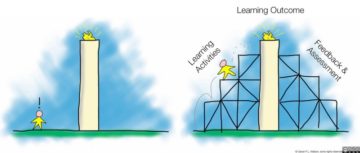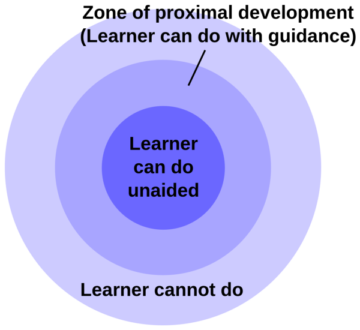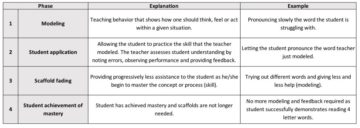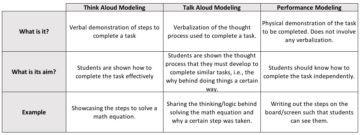Contextualized instruction, as it suggests, refers to teaching students the content in a context, i.e., embedding the concepts in meaningful activities and in a scenario that makes sense to the students to enhance their understanding and to make the concepts more relatable. It is important to remember that skills that we want to teach to students, such as problem solving, analytical thinking or even dribbling a ball, do not exist in isolation; using purposeful contexts and learning activities, we can show students where these skills are applicable and why they should know them.
Scaffolding is one such process that allows the students to work in a contextualized setting and solve problems while focusing on building the associated skill. The following figure presents a pictorial representation of how scaffolding works — if we want a student to achieve the learning outcome which is new to them and out of their reach (by virtue of being on top of a building), we can build scaffolds or supporting structures around the building to help the student get to the learning outcome. These supports involve meaningful activities and continuous feedback and assessment to ensure that the student is able to build independence. Like scaffolds in construction, the scaffolds in teaching are temporary structures that are removed, i.e., less and less feedback is offered, as the student develops the targeted skill.

Scaffolding focuses on the skills involved in the task rather than completing the task itself. This is because our aim for instruction to make students independent and be able to use what they have learned in other contexts — to generalize their knowledge and use it in other settings.
Here is a short video by Albert Education on scaffolding:
Zone of Proximal Development by Vygotsky
Scaffolding cannot be explained without mentioning Vygotsky’s research on how people learn. He believed that development happens because we learn and, in order to learn, we must be presented with tasks that are just out of our reach. For example, when a child who is able to read three-letter words comfortably, is presented with a four-letter word, he might not know how to pronounce it initially, but with a little bit of help from the teacher — reminding him to break down the word into syllables — he would be able to say the word and this ‘skill’ will then be available to him to apply for other words, four-letter or more.

Learning can be divided into two zones: the zone of actual development and the zone of proximal development. The zone of actual development is the one in which students apply techniques and skills they already know and are successfully able to complete tasks. The zone of proximal development is when help from a more knowledgeable person allows the students to master a new skill and learn through guidance and encouragement. In our above example, when the child is given a three-letter word, he is in the zone of actual development. When confronted with the four-letter word, he is in the zone of proximal development. This is the zone where new skills are learned.
A third zone that exists is one that is beyond the students reach even if the teacher was to help. These are skills that they are missing key knowledge of.
Characteristics of Scaffolding
- It is a collaborative interaction with someone who is more knowledgeable. This could be a teacher, a parent and even a peer.
- It operates in the zone of proximal development. The student is provided support and help only for the skills that are needed to solve a task which is just a little out of his/her reach.
- It is withdrawn as the learner becomes more competent in using the skill.
Scaffolding is a recommended practice for acquiring a skill by analyzing how, when and why it should be used. This is achieved by embedding it in a relevant context.
Phases of Scaffolding
Scaffolding operates in four distinct stages. Let us review these four stages in the context of the reading situation mentioned above. Let us assume that the student is proficient in reading phonic books with three-letter words and now the teacher is working with him on a higher level book with four letter words. The context here is the story that they are reading.

Note that the indicator of student achievement in this case is the successful reading of four-letter word in the book being used. This does not mean that the student can now go and read any four-letter words. It does mean, however, that the student was able to achieve the functional goal of reading four-letter words in the book even when his overall competence of reading four-letter words and higher is limited to simple books.
Modeling
Since modeling is the first phase of scaffolding and focuses on how the student should feel, think or act, it can be divided into three strategies for instruction, as shown below. Let us analyze them in context of solving a math equation.

Think aloud and talk aloud modeling are similar to each other as both involve verbalization, showing the students how to approach the situation at hand. Performance modeling, on the contrary, shows the students the correct way of solving the situation.
Types of Scaffolds
Scaffolds are of two types: structural scaffolds and interactive scaffolds.
- Structural scaffolds are static in nature and can be preplanned before the class. These could be in the form of inquiry questions that the teacher could ask, any objects that she might have available in the classroom for engaging students more, especially those who need more ways of representation of the problems. Setting up the activity in advance and allowing for repeated opportunties to practice the skill are all structural scaffolds. They are created by:
> engineering the context, i.e., the activity in which the students will learn the skill
> skill routine, i.e., predictable order of steps in the activity. - Interactive scaffolds are dynamic in nature and are responsive actions taken during the instruction to address student needs. These are the scaffolds that are systematically withdrawn as skills are learned. Being aware of the frustration level of students, demonstrating solutions when the student cannot see them are some examples of interactive scaffolds that can only happen in class.
Peers are a scaffold as well and depending on how the class is set up, they can ask as both structural and interactive scaffolds. Can you think of ways you can use peers for scaffolding while teaching content of your choice?
Challenges of Scaffolding
- As teacher, we want to help our students as much as possible. However, with scaffolding, it becomes important to stop giving help when we start to see that the student is on the right path of success. This giving up on control can be hard and it might be harder to watch students make errors and struggle.
- The right amount of scaffolding is important — too much would lead to boredom while too little would cause the students to become frustrated.
Scaffolding vs Shaping
Last but not the least, there is another concept related to scaffolding: shaping.
Shaping is discrete skill instruction which does not involve a context and focuses on the development of the skill, by sequentally mastering the subtasks. Independent mastery must be achieved on a subtask before progressing to the next one. The major difference between shaping and scaffolding is that shaping is not contextualized. For example, teaching students how to dribble a ball without telling them that it is used in basketball is discrete skill instruction.
Shaping and scaffolding share some commonalities as well.
- Both involve task analysis, which involves analyzing the activity the teacher wants to do with the students, the complexity of the activity, any necessary equipment and environmental conditions, etc.
- Task demands are reduced by simplifying the skill to be learned. For example, the focus of the reading situation was on four-letter words only.
- Both support student learning.
Conclusion
As promised in my last post on differentiated instruction, in this article I elaborated on teaching through scaffolding. I was only able to scratch the surface here and I hope that the examples were helpful. Please let me know if you have any questions or would like me to do a follow-up post on any of the mentioned concepts. I did not elaborate on shaping a lot and if you would like to read more about it here, give me a shout. Vygotsky’s theory of learning as well as other theories of learning are topics I will write about in the future.
Leaving you today with a thought, which gives a glimpse into how peers can be used as scaffolds (sneaky indeed!) and why:

Reference:
The content in this article is based on my notes from lectures on Adaptive Education (EDPY 301, University of Alberta, Winter 2018). The text we are reading is: Hutchinson, N. L. (2013). Inclusion of exceptional learners in Canadian schools: A practical handbook for teachers. Pearson Education Canada.
Video:
Alberta Education (2015, January 30). Scaffolding for student success [Video File]. Retrieved from https://www.youtube.com/watch?v=CTR_snb-0nQ&t=44s

Be First to Comment